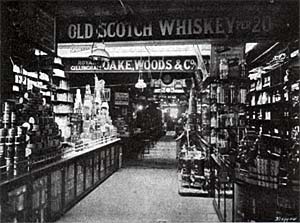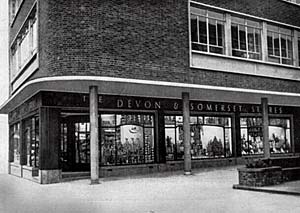
Devon and Somerset Stores
Page added 22nd February 2017
Return to Retail Exeter
One of the largest grocery stores in Exeter until the Second War was the Devon and Somerset Stores. Piecing together its history is difficult because of the lack of documentation, but adverts, news paper articles and research into James Hare, the founder, exposes an interesting business that supplied the great and the good with their tea, grocery supplies and wine and spirits.
James Hare, who was born in Taunton in 1848, opened his first grocery business in Bristol. He must have been a natural entrepreneur from a young age, for he was just 23, when he opened his second store in Taunton in 1870. One source suggest his two shops were called the Three Canister Tea Company, which makes sense, as he had not yet opened in Devon. Business was good, for in 1873, a newly married Hare (his eldest son, Henry was born in the same year) opened a third shop in Exeter, at 245 High Street. Hare moved wife Jane and cildren down to Exeter, renting Weircliffe House in Exwick from the Bullers. By 1878 he lived at 4, The Quadrant, Mount Radnor Place, an address that indicates a prosperous middle class lifestyle.
He quickly expanded in the city, opening in Queen Street and Heavitree. By 1878, the business was known as the Devon and Somerset United [Co-operative] Stores. The 1881 census indicates that Hare employed 34 men and 12 boys, probably across all his shops.
A report in the Bristol Mercury in May 1880 reports a fire in the Bristol store. The fire was thought to have started in a match store on an upper floor. The insurance loss was estimated at between £1,000 and £2,000.
James Hare and Honeylands
Despite the fire, business must have been good across the branches, for in 1883, James Hare moved his family to the rather larger Honeylands House in Whipton. He had married Jane and had two sons and three daughters, one of whom died at the age of six. The family could afford to advertise for a French or Swiss nursery governess for their growing family. One daughter, Mary, became well known across Exeter in the decade before the Great War for her interest in photography and recording many of Exeter's buildings. Henry, the eldest eventually joined the business in Exeter, while John went on to run the Taunton branch. In 1888, a notice in the Standard indicates that Hare was an investor in the Exeter Tramways Company, indicating his businees credentials.
Some news items
There were occasional short news articles in the Flying Post about the store – one such, in 1889, reported that the shafts snapped on a horse drawn delivery van which was being laden with some heavy goods. The van tipped backwards and the frightened horse set off with the broken shaft still attached, before it was stopped near to the Guildhall.
The business regularly advertised in the local press, including the Flying Post – the adverts were varied, week by week, emphasising the latest stock and price. They claimed to stock up to 30,000 gallons of wine and spirits which they imported directly from the producers. They also posted leaflets to their regular customers, free of charge.
The shop front in the High Street, dramatically collapsed at 10pm on 29th August 1894, after supports propping up 246 High Street, which was being rebuilt and incorporated into 245, failed. The building had been an Apothecaries Hall and then a florist before it was purchased by Hare for his expansion. A temporary arcade was erected at the rear of the building, while the repairs and building of the new expanded store continued. By the 1st of September, a notice in the Flying Post proclaimed that the 'The stores are again open.' A report in the same edition stated that the collapse was less dramatic than first reported, and part of the building was to have been demolished the next day, and that little stock had been lost, while part of the premises had re-opened for business. A year later, a short report appeared that stated that Hare had settled with Ham and Passmore, the contractors of his new premises. A large advert for the 6th July 1895 stated that the business had been transferred from their Queen Street branch to the new 245 to 246 High Street premises on the 1st July. The Queen Street store was a temporary measure, and a sale was held with a 20% reduction to clear the stock.
The company published a Souvenir of Exeter and Neighbourhood, a book of photos of Exeter, to celebrate the opening of the new store, circa 1895.
"Phone your order, Sir"
A story goes that when the Devon and Exeter Institution in Cathedral Close first installed a telephone in 1899, the members were keen to use the new device, as few of them owned a telephone at home. Some circumvented this minor inconvenience by going to the Devon and Somerset Stores, who also had a phone, and browsing the goods stocked by the shop. They would then return to the Institution and very loudly phone the shop to make their weekly order, and no doubt impress their friends at the same time.
James Hare died on the 18th April 1920, and his widow and two daughters sold Honeylands and grounds, to a Mr Hamblin, for £4,000. The family moved into the Red House in Whipton Village House.
Hare's eldest son, Henry, or Hal as he was more generally known, took over the reigns. The business was incorporated on 18th April 1924 under his management. The store was very much a personal service establishment, with counter staff and delivery boys, very similar to the Home and Colonial Stores and International Stores, both of which had branches in the city.
Hal died on 6th May 1937 and was succeeded by his brother in law, Mr L Crews.The shop in the High Street was substantially updated in 1939, but the dark clouds of war were looming, bringing rationing, and more austere times.
Destruction in the blitz
The blitz of May 1942 resulted in the total destruction of the shop. Reports at the time suggest that the Devon and Somerset Stores could have been saved if there had been sufficient hose pipes – one fire guard stated:
"… a static water tank at the rear of the premises holding hundreds of gallons of water, which was also not used during the raid, and easy access at the rear to the Rougemont Gardens where ample supplies of static water were available. It is his opinion that one hosepipe would have been sufficient with the amount of water to have saved the Devon and Somerset Stores as all the bombs had been extinguished and the fire, which eventually completely destroyed the building, did not spread to the premises until after the "raiders past". The fire guard fought the flames in the premises until 4.17am when they were driven out by the size of the conflagration, which subsequently gutted both these premises …"
Some thought had been made about the possibility of the loss of business through bombing, and the company had stored much of its stock at the Heavitree branch, which became the de facto main Exeter store.
The war may have removed the Devon and Somerset Stores from the High Street, but in the 1950s they had branches at 53 Fore Street, Heavitree, 47 Longbrook Street, 17 Southbrook Road and 46 Whipton Village Road. The Southbrook branch was Tollards Stores, and acquired in September 1942. They sold the premises in August 1955, no doubt having served the purpose after the loss of their store in te High Street.
Mr Crews died in September 1950 and Hal's daughter, Mrs B M Mock became managing director. United Counties Stores of Bristol acquired the business in November 1954. United County were started by Samuel Budgett in 1820, becoming a prominent wholesale grocer across the Midlands and South West England. In 1932 they offered shares in United Counties Stores, that concentrated on running small, already established retail stores.
The Devon and Somerset Store returned to the centre of Exeter on 12th December 1955, when they moved into a prime site at 1,3 & 5 Princesshay (Bedford House). They also had a store at 53 Queen Street on the corner with Richmond Road. However, the large supermarkets were circling, and the 100 year old business was struggling to compete. On 24th August 1982 they were removed from the Register of Companies, although they had closed sometime before.
Source: Whites 1878 Kelly's 1902, 1956, 1967, Trewman's Exeter Fling Post, The Times, The Standard, London Gazette, Express and Echo, History of the Devon and Exeter Institution by Roger Brien, the history page of www.jackgodfrey.org.uk, and Exeter Burning by Peter Thomas. Deeds for the Southbrook Road store kindly loaned by Deborah Benney.
 The store was rebuilt in 1894 - this photo was included in the Souvenir of Exeter and Neighbourhood book, probably in 1895. Click to enlarge.
The store was rebuilt in 1894 - this photo was included in the Souvenir of Exeter and Neighbourhood book, probably in 1895. Click to enlarge.
 The store sometime after the First War - notice that 247 High Street has been incorporated into the store.
The store sometime after the First War - notice that 247 High Street has been incorporated into the store. The interior of the store in the 1930s.
The interior of the store in the 1930s. The Devon and Somerset Stores in Bedford House, Princesshay.
The Devon and Somerset Stores in Bedford House, Princesshay.
If you have memories or further information on the Devon and Somerset Stores, please EMail me so that I can add it to this page.
│ Top of Page │